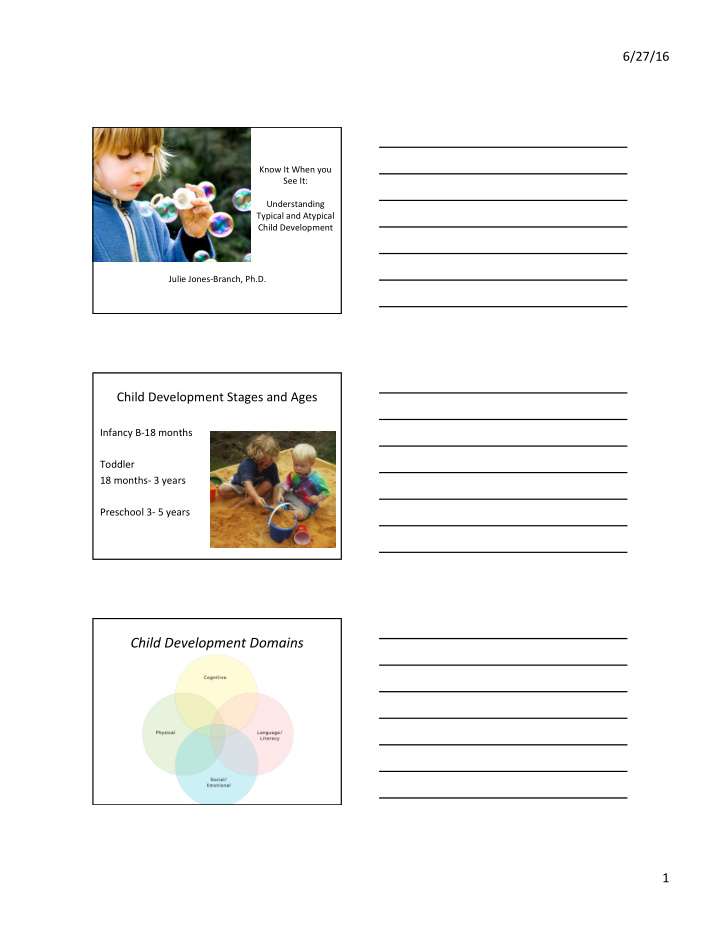



6/27/16 Know It When you See It: Understanding Typical and Atypical Child Development Julie Jones-Branch, Ph.D. Child Development Stages and Ages Infancy B-18 months Toddler 18 months- 3 years Preschool 3- 5 years Child Development Domains 1
6/27/16 Cogni&ve—Brain Development Synapses strengthen through exposure to repeated, meaningful experiences CriOcal Periods and Pruning 2
6/27/16 Stages of CogniOve Development Piaget Sensorimotor—B-2 years Pre-OperaOonal—2-7 years Concrete OperaOons—7-11 years Formal OperaOons—12+ years Brain is not fully developed un6l mid-20s What do they need? • Predictable, TrusOng environments • Less stress is best – (toxic shock) • SOmulaOon of their senses – Sight, Sound, Smell, Taste, Feel • Novelty What can Adults do? • Provide consistent, reliable rouOne • Offer variety of materials (sounds, textures) • Support children’s exploraOon – Describe/label environment – Show enthusiasm of children’s new discoveries • Understand stages of brain/cogniOve development to set appropriate expectaOons 3
6/27/16 Physical Development Large and Small Motor Large Motor Sequence Put the following 8 skills in order of ‘sequence’— add what approximate age it should occur: Running Rolling Over Kicking Cutting Crawling Skipping Catching Walking h_p://www.pbs.org/wholechild/abc/physical.html Tracking 4
6/27/16 Importance of Tummy Time What do they need? • Space • Time • Variety of surfaces and textures – Safe heights What can Adults do? • Provide Ome, space and materials to explore • Encourage • Support physically – Help them ‘move’ from one skill to the next 5
6/27/16 Sequence of Fine Motor Development Stages/Sequence of WriOng What do they need? 6
6/27/16 What can Adults do? • Offer opportuniOes with a variety of materials • Encourage by noOng a_empts and asking children to share what they have wri_en/ drawn • Do not criOcize ‘incorrect’ le_ers/pictures Language/Literacy Development RecepOve vs. Expressive Stages of Language Development (Birth to Age 3) 1. Crying 2. Cooing 3. Babbling 4. Gestures (8-12 months) 5. First words (8-18 months) 6. Telegraphic speech (18-24 months) 7. GrammaOcal speech (~2 ½ years) 7
6/27/16 The 1995 Hart & Risley Study Meaningful Differences in the Everyday Experience of Young American Children by Betty Hart, Ph.D., and Todd R. Risley, Ph.D. “ With few excep&ons, the more parents talked to their children, the faster the children ’ s vocabularies were growing and the higher the children ’ s IQ test scores at age three and later. ” “ The data revealed that the most important aspect of children ’ s language experience is its amount. ” Every Child Ready to Read h_p://www.everychildreadytoread.org/ Talking One of the best ways to get them to learn new words and informaOon Singing Natural way for children to learn about language Reading Reading together is the single most important way to get children ready to read. WriOng Shows connecOon between reading and wriOng. Spoken words can be wri_en down. Playing Helps put thoughts into words and to think symbolically 8
6/27/16 What do they need? • To hear language – Read to – Talked to • To be able to have adults respond to their a_empts at language Strategies for Extended Conversa&on (the more turns the beAer) • Show Interest • Paraphrasing • Repea6ng and pausing • Open-ended ques6on • I wonder Statements • Connect to previous experiences 9
6/27/16 Extending the Conversation A Mother-Son Story Mom [ buying bread at a little shop]: Sam, where do you think they get this bread? Sam [age 4.5]: They must make it at the back of the store. Mom [pause]: Do you remember when your school went to the bakery factory and saw them make bread? Sam : Yes. They must have a little machine like that in the back of this store. Mom : Hmm. How about these vegetables they are selling? Sam : They must grow them right out back of the store. Mom : Sometimes we go on drives in the countryside and see farms where vegetables are growing. Sam : That food is sold is stores in the country. But not in our store here. Sam = 4 turns Social/Emo&onal Development Stages of Play—Social Onlooker/Solitary Play Parallel AssociaOve CooperaOve 10
6/27/16 Self-RegulaOon • Ability to calm • Self-control • EmoOonal recogniOon EmoOons and Self-RegulaOon “ I hate you! ” “ I don ’ t want to be your friend! ” “ You are NOT invited to my birthday party! ” All of these statements MEAN… ‘Feelings come and feelings go … .sometimes I don’t know what they’ll be. Whatever the feelings are, they are all a part of me!’ 11
6/27/16 What do they need? • TrusOng relaOonships • Time to develop • OpportuniOes to play with others and self-select acOviOes • Understanding of adults • Adults to facilitate and support them What can Adults do? • Structure environment for least amount of stress – Should offer predictability and consistency • Recognize signs of basic needs • Name emoOons • Suggest words to work through the situaOon • Offer physical support • Stay calm and neutral Resources 12
Recommend
More recommend